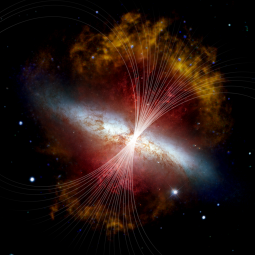By Joan Schmelz
Paper:
The Strength and Structure of the Magnetic Field in the Galactic Outflow of Messier 82
Lopez-Rodriguez, E., et al., 2021 ApJ 914 24
Observations of M82, a canonical starburst galaxy, reveal a bipolar superwind that originates in the core and extends out into the halo and beyond. Early observations from HAWC+ show that the geometry of the field at the base of the superwind is perpendicular to the plane of the galaxy, consistent with a scenario where the outflow is dragging the field along with it.
Do these magnetic field lines extend forever, channeling matter into intergalactic space, or do they turn over, directing material back to the galaxy in a giant feedback loop? This question is reminiscent of an analogy from solar physics — are the field lines emanating from the Sun open, like those in the solar wind, guiding particles from the solar surface to interplanetary space, or are they closed, like coronal loops, forming the complex structure of the solar atmosphere? We turned to a well-tested technique used in heliophysics — the potential field extrapolation — to answer this question.
With only rare exceptions, the magnetic field in the solar corona cannot be measured directly. Therefore, significant effort has been invested by the community into extrapolating the field measured at the surface via the Zeeman Effect up into the solar atmosphere. The simplest of these approximations assumes that the electrical currents are negligible so the magnetic field has a scalar potential that satisfies the Laplace equation and two boundary conditions: it reduces to zero at infinity and generates the measured field at the photosphere.
We have modified the solar potential field method to work with the HAWC+ data in order to extrapolate the core field and investigate the potential magnetic structures in the halo of M82. The two-dimensional Cartesian set up places the center of M82 at (x,z) = (0,0) and the galactic plane along the x-axis. The first boundary condition involves the B-field values determined from the map described below at B(x,0) and the second, like the solar case, assumes that B(x,∞) = 0.
We used the HAWC+ polarimetric data from SOFIA and the Davis-Chandrasekhar-Fermi (DCF) method to estimate the plane-of-the-sky magnetic field strength in the central starburst region of M82. This method relates the line-of-sight velocity dispersion and the plane-of-sky polarization angle dispersion. It assumes an isotropically turbulent medium whose turbulent kinetic and turbulent magnetic energy components are in equipartition. Using mean values of mass density, velocity dispersion, and polarization angle from the literature and, for the first time, modifying the DCF approximation to account for the galactic superwind by adding a steady-flow term to the wave equation, we find that the average magnetic field within the starburst region is 0.77 ± 0.45 mG.
We also defined the Turbulent Plasma Beta, β′, as the ratio of thermal-plus-turbulent pressure to magnetic pressure and estimate β′ = 0.56 ± 0.23. We can then use the pixel-by-pixel values of the mass density and velocity dispersion to construct, for the first time, a two-dimensional map of the magnetic field strength in the inner regions of M82. We input the B-field values along the galactic plane into the modified potential field extrapolation code. The resulting magnetic field structure is shown in the figure above.
These results indicate that the observed turbulent magnetic field energy within the starburst region is composed of two components: a potential field arising from the galactic outflow and a small-scale turbulent field arising from a bow-shock-like region. This result represents the first detection of the magnetic energy from a bow shock in the galactic outflow of M82.
The results of the potential field extrapolation allow us to determine, for the first time, if the field lines are open or closed. Since the turbulent kinetic and magnetic energies are in close equipartition at 2 kpc (measured) and 7 kpc (extrapolated), we conclude that the fields are frozen into the ionized outflowing medium and driven away kinetically. These result indicate that the magnetic field lines in the galactic wind of M82 are open, providing a direct channel between the starburst core and the intergalactic medium. The powerful winds associated with the starburst phenomenon appear to be responsible for injecting material enriched with elements like carbon and oxygen into the intergalactic medium.
Magnetic fields generated by turbulent gas motions arising from galactic outflows, mergers, and active galaxies may permeate the intergalactic medium. Here, we used the HAWC+ data and a potential field extrapolation to trace the magnetic fields in the galactic outflow of M82 and quantify how these fields may magnetize the intergalactic medium. We demonstrated that far infrared polarization observations provide a powerful tool to study the magnetic field morphology in galactic outflows. Ongoing efforts like the SOFIA Extragalactic Magnetic Fields Legacy Program will provide deeper observations of the large-scale magnetic field structure in the disk of M82 as well as other nearby galaxies. This work serves as a strong reminder of the fundamental importance of magnetic fields, often completely overlooked, in the formation and evolution of galaxies.
